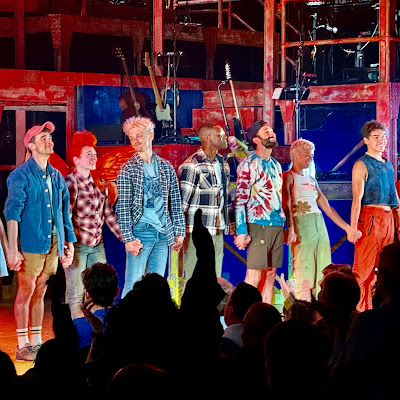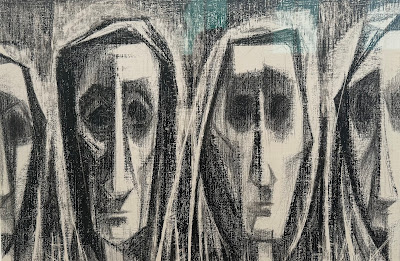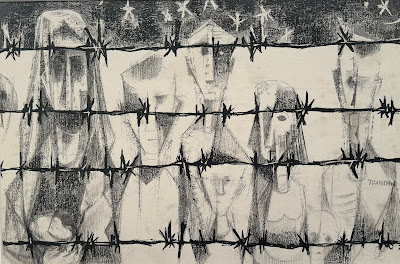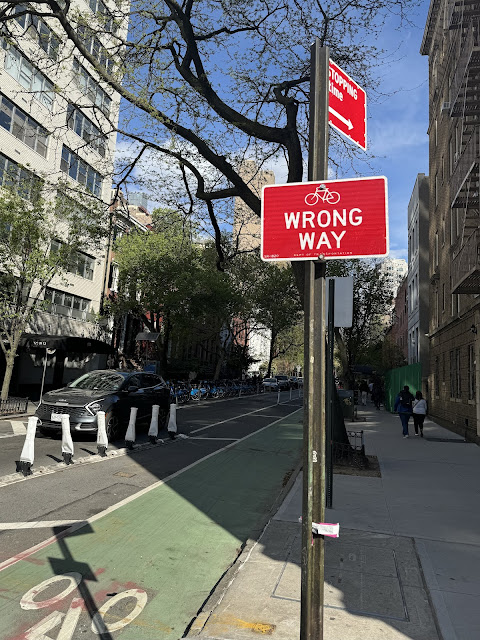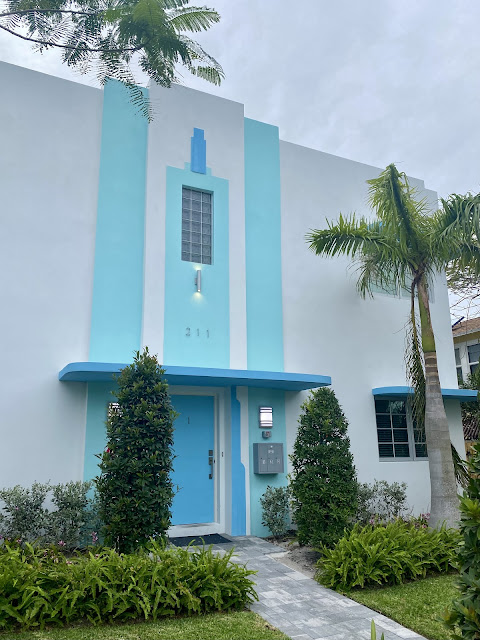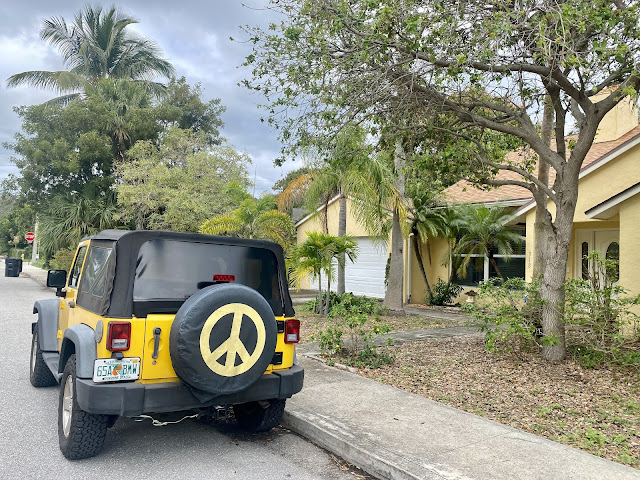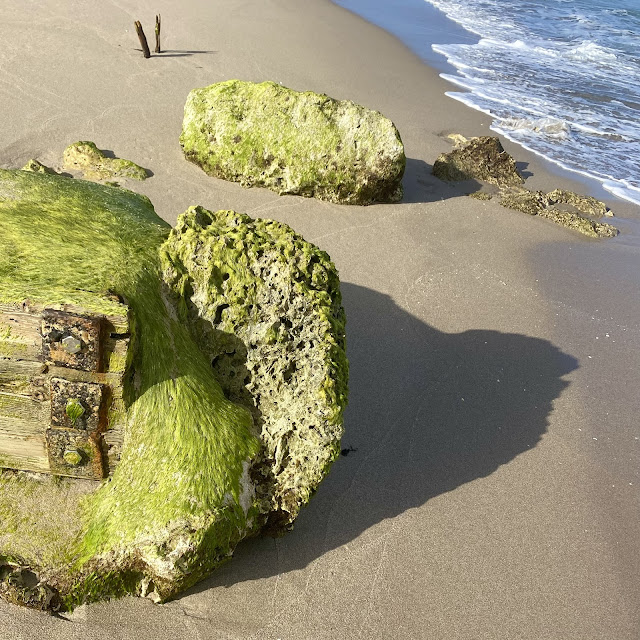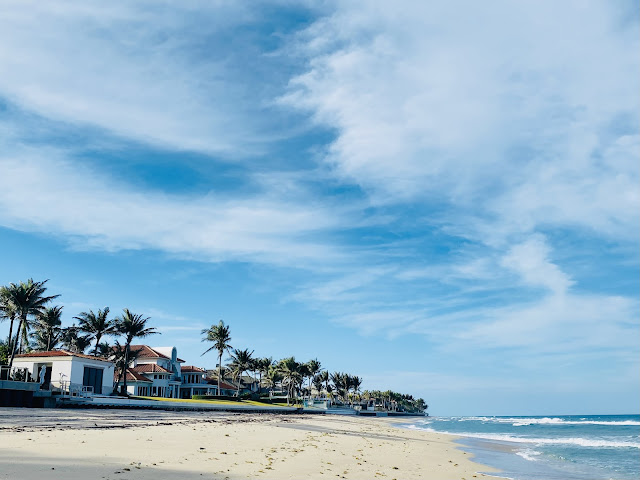Saturday, April 27, 2024
The Fraud (4*)
Thursday, April 25, 2024
Illinoise (4*)
Wednesday, April 24, 2024
"The Parade"
Lewen traces the phases of war in 63 black and white drawings, without a word. Excited crowds waving flags line the streets in the first surge of patriotism prior to the commencement of battle. The recurring dog seems to function as a witness.
Goose-stepping soldiers hold their rifles at the same angle as their legs.
Lewen's approach reminds me a little of Civil War, a controversial film directed by Alex Garland. These soldiers lack ideology, too. They could be Israelis or Palestinians.
A parent holds up a child with a flag in support of whatever the cause, inculcating a new generation with hatred.
I can't tell if this child is gazing into a parent's eyes. Or a nun's. Or death's.
Despite everything he saw and endured, Lewen kept his sense of humor. In this scene, which recalls the absurdity of the war in Viet Nam for my generation, medical personnel examine conscripts to ensure they're healthy enough to kill people.
Basic training, just like in Full Metal Jacket, an equally powerful anti-war film by Stanley Kubrick who also directed Paths of Glory, which examines the inhumanities of military decision-making.
The high velocity of civilian death is inevitable and propulsively illustrated.
Lewen had to flee home three times during his life. First, as a toddler, after his family's home in Lublin was burned to the ground in a progrom, then as a 13-year-old to avoid increasing anti-Semitism in Berlin and finally, a miraculous escape to America in 1935, when Jews weren't permitted to immigrate.
Battlefield horrors vary.
These people are the lucky ones. If you're injured, at least you're alive.
In 1951, when Lewin first exhibited his drawings in New York, Albert Einstein, then a Princeton professor, took notice and wrote him a fan letter:
How Many Times . . .
Sunday, April 21, 2024
Patriots (5*)
While employed at the NYC Health Department, I'd even been assigned to do a deep dive on radiation poisoning after Putin had dispatched Alexander Litvinenko, perhaps the earliest of his regime's extrajudicial killings and visited his grave in London's Highgate cemetery. But Morgan connects all the dots among these men in an electrifying, often funny drama that depicts how the political miscalculation of the smartest man in the room--a brilliant mathematician who seized the moment to ruthlessly capitalize his beloved homeland--produced one of the world's shortest monsters and inched the West as close to nuclear confrontation as it has been since Khruschev (whose daughter consulted on this production) installed missiles in Cuba.
Patriots also manages to whip up what may be some misplaced sympathy for "the Jew behind the czar" who, in Morgan's telling, eventually comes to appreciate the merits of the path not chosen thanks to the example of his academic mentor, a stand-in for the long-suffering Russian soul, whose belief in the neutrality of numbers remains steadfast. Superb performances all around, brisk, cinematic direction by Rupert Goold that moves the nearly three-hour production along as breathlessly as a Fox News segment and a set that emphasizes alcohol's indispensability to Russian culture make this highly theatrical history lesson not to be missed. Even if it's not accurate, it's probably true.
But if I were Morgan, I would be afraid, very afraid. Radiation poisoning is no way to die.
Thursday, April 18, 2024
Black Leather Vanity @ Tiffany's
 |
| "Peter Marino" by Julian Schnabel (2022) |
 |
| Peter Marino by Michelangelo Pistoletto (2023) |
 |
| "Angelus Novus X" by Francesco Clemente (2022) |
 |
| Untitled (Girl with No Eyes) by Julian Schnabel (2001) |
 |
| "Picasso" Works by Richard Prince (2011-12) & "Kalao Pink" by Antoine Poncet (1991) |
 |
| Untitled (Cowboy) by Richard Prince (2012) |
 |
| "Tiffanies and Tiffany" by Urs Fischer (detail, 2022) |
 |
| "Salivary Cell" by Damien Hirst (detail, 2007) |
 |
| "Bronze Eroded Venus of Arles" by Daniel Arsham (2022) |
Luxury retail outlets give me a severe case of imposter syndrome. Uncharacteristically, in recent years I've bought three baby gifts from the store, including one of the Steiff elephants flanking the middle shelf. It's hard to believe how much the Tiffany's branding increases the cost.
This would have been more up my alley as a kid. I still have a thing for seahorses.
Look up at the ceiling in the cafe and you'll see dozens of gift boxes hanging by ribbons.
The floral arrangements really are something.
Wednesday, April 17, 2024
"Gorgeous" Times Four
 |
| Riverbend Park, Jupiter |
 |
| The Bass Museum, Miami |
 |
| The Manatee Lagoon, Riviera Beach |
 |
| Holocaust Memorial, Miami |
 |
| The Bunker, West Palm Beach |
 |
| Wynwood, Miami |
 |
| En Route to MacArthur Park |


